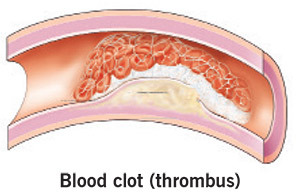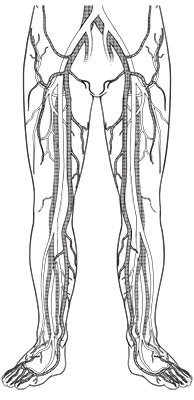What is a deep vein thrombosis?

A deep vein thrombosis (DVT, also called venous thrombosis) is a blood clot in a vein deep in your body. It usually happens on one side of the body. The clot may limit or completely block blood flow through the vein. Most DVTs form in the lower leg, thigh and pelvis. They can also form in other areas, such as the arm, brain, intestines, liver and kidneys.
What problems can a DVT cause?

A DVT, itself, is not life-threatening. But, the blood clot can break free, travel through your bloodstream and get stuck in a blood vessel inside your lung. This condition is called a pulmonary embolism (PE) and can be life-threatening. It is important to find out if you have a DVT as soon as possible and get treatment.
Another problem caused by a DVT is chronic venous insufficiency (also called post-thrombotic syndrome). This means the walls and/or valves of the veins in your legs aren’t working well. Blood collects in the veins and causes chronic leg swelling, increased pressure, dark or discolored skin, and open sores on the legs called venous stasis ulcers.
What is the difference between a DVT and a superficial venous thrombosis?
A superficial venous thrombosis (also called phlebitis or superficial thrombophlebitis) is a blood clot that forms in a vein close to the surface of the skin. These types of blood clots do not usually travel to the lungs. But, they can move from the superficial system into the deep venous system and into your lungs.
What are the symptoms of a DVT?
Not everyone with a DVT will have symptoms, but symptoms can include:
- Swelling in your leg or arm (this can happen suddenly) - area may hurt or be warm.
- Pain or tenderness in your leg (may happen only when standing or walking).
- Red or discolored skin.
- Larger than normal veins near the surface of your skin.
Symptoms of a PE include:
- Sudden shortness of breath or fast breathing.
- Sharp chest pain often with coughing or breathing.
- Back pain.
- Cough (sometimes with bloody phlegm).
- Sweating more than normal.
- Fast heartbeat.
- Feeling dizzy or fainting.
Some people do not know they have a DVT until the clot moves from their leg or arm to their lung.
Call your doctor right away or go to the emergency room if you have symptoms of a pulmonary embolism or DVT. Do not wait to see if the symptoms stop. Get treatment right away to prevent serious complications.
What causes a DVT?
The following increase your risk of a DVT:
- An inherited (genetic) condition that increases your risk of blood clots.
- Cancer and chemotherapy.
- Reduced blood flow in a deep vein caused by: Sitting for a long period of time in a car, truck, bus, train or airplane. Lack of movement after surgery or a serious injury.
- Pregnancy and the first 6 weeks after giving birth.
- Being over age 40 (although people of all ages can get a DVT).
- Being overweight.
- Taking birth control pills or hormone therapy.
- Having a central venous catheter or pacemaker.
How is a DVT diagnosed?
Your doctor will do an exam, review your medical history and order tests. Common tests to diagnose a DVT are:
A duplex venous ultrasound. This is the most common test used to diagnose a DVT. It shows the blood flow in your veins and any blood clots that exist. An ultrasound technician will apply pressure while scanning your arm or leg. If the pressure does not cause the vein to compress, it could mean there is a blood clot.
You may also have:
- Magnetic Resonance Imaging (MRI) or Magnetic Resonance Venography (MRV): MRI shows pictures of organs and structures inside your body, and MRV shows pictures of your blood In many cases, MRI and MRV can offer more information than an X-ray.
- Computed tomography (CT) scan is a type of X-ray that shows structures inside your body. A CT can help find a DVT in your abdomen or pelvis, as well as blood clots in your lungs (pulmonary embolism).
- Venography. This test uses X-rays to look at your deep veins. A special dye (contrast material) is injected into your veins so the X-rays show the veins and any blood clots. It may also show any blockage in blood flow. Venography may be used if the results of the duplex ultrasound aren’t clear.
If your doctor thinks you may have a genetic disorder that causes blood clots, you may need blood tests. This may be important if:
- You have a history of blood clots that cannot be linked to any other cause.
- You have a blood clot in an unusual location, such as in a vein from the intestines, liver, kidney or brain.
- You have a strong family history of blood clots.
Who is at risk of developing a blood clot?
If you have a personal or family history of blood-clotting disorder, DVT or pulmonary embolism (PE), you could be at risk.
Activity guidelines
A DVT may make it harder for you to get around at first. Slowly return to your normal activities. If your legs are swollen or feel heavy, lie in bed with your heels propped up 5 to 6 inches. This helps improve circulation and decreases swelling.
Also:
- Exercise your lower leg muscles if you need to sit still for a long time.
- Stand up and walk for a few minutes every hour while you are awake.
- Don’t wear tight-fitting clothing that can decrease circulation in your legs.
- Wear compression stockings if your doctor recommends them.
- Avoid activities that can cause a serious injury.
What treatments are available for patients with a DVT?
Treatments for a DVT include medications, compression stockings and elevating your leg. Depending on how bad the clot is, you may need invasive testing and treatment, including hospitalization. Your doctor may consider using catheter-directed therapy (CDT) for your pulmonary embolism depending upon the seriousness of your blood clot. This procedure requires placement of catheters directly into your pulmonary arteries, where lower doses of thrombolytic therapy (clot buster) is given.
The main goals of treatment are to:
- Stop the clot from getting bigger.
- Prevent the clot from breaking off in your vein and moving to your lungs.
- Reduce the risk of another blood clot.
- Prevent long-term problems caused by the blood clot (chronic venous insufficiency).
Important information about medication
- Take your medications exactly as your doctor tells you to.
- Have blood tests as directed by your doctor and keep all scheduled lab appointments.
- Do not stop or start taking any medication (including nonprescription/over-the-counter medications and supplements) without asking your doctor.
- Ask your doctor or pharmacist if you need to make changes to your diet while you are taking your medication.
Medications
Anticoagulants ("blood thinners"). This type of medication makes it harder for your blood to clot. Anticoagulants also keep clots from getting bigger and moving. Anticoagulants do not destroy clots. Your body may naturally dissolve a clot, but sometimes clots do not completely disappear.
If you cannot receive blood thinners due to bleeding or recent surgery or trauma, an Inferior Vena Cava (IVC) filter may be necessary. The filter is put in place during minor surgery. It is inserted through a catheter into a large vein in your groin or neck, then into the vena cava (the largest vein in your body). The filter catches clots as they move through your body.
If you need to take an anticoagulant, you may only need to take it for 3 to 6 months. But, your treatment time may be different if:
- You have had clots before, your treatment time may be longer.
- You are being treated for another illness (such as cancer). You may need to take an anticoagulant as long as your risk of a clot is higher.
The most common side effect of anticoagulants is bleeding. Call your doctor right away if you bruise or bleed easily while taking this medication.
Catheter-directed therapy. Your doctor may recommend catheter-directed therapy (CDT) if you have a PE. This involves putting catheters into your pulmonary arteries and using "clot-busting" drugs (thrombolytic therapy) to break up the PE.
Compression stockings
You will likely need to wear graduated compression stockings to get rid of leg swelling. They add pressure to your veins in your legs. Most compression stockings are worn just below the knee. These stockings are tight at the ankle and become more loose as they go up the leg. This causes gentle pressure (compression) on your leg.
Can a DVT be prevented?
If you have had a DVT, you can reduce your risk of future clots by:
- Taking your medications exactly as your doctor tells you to.
- Keeping your follow-up appointments with your doctor and the lab. These are needed to see how well your treatment is working.
If you have a high risk of getting a DVT but have never had one:
- Exercise your lower leg muscles if you need to sit still for a long time. While traveling, walk at least every half hour during long flights and get out of the car and walk every hour while on long road trips.
- Get out of bed and move around as soon as you can after you are sick or have surgery. The sooner you move around, the less chance you have of developing a clot.
- Take medications or use compression stockings after surgery (if prescribed by your doctor).
- Follow all of your doctor’s recommendations to reduce your risk of a clot and keep all follow-up appointments.